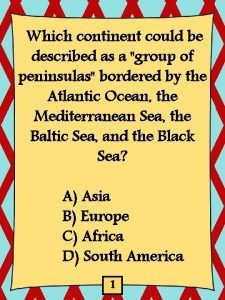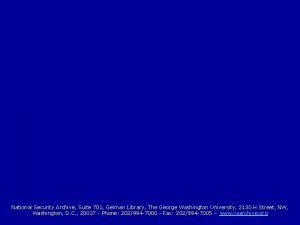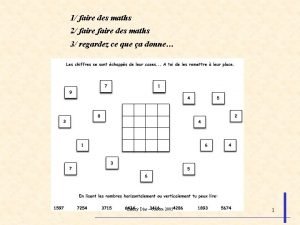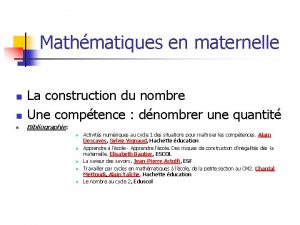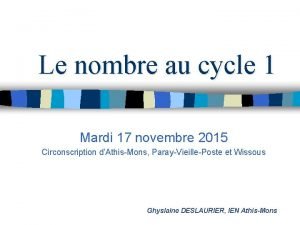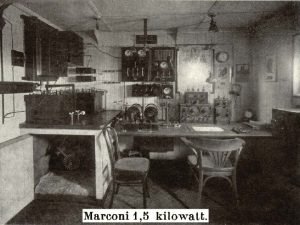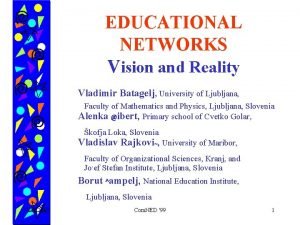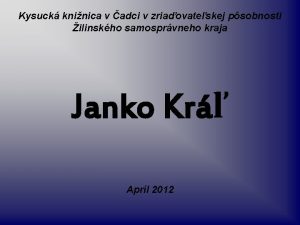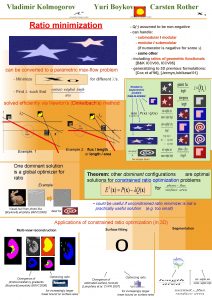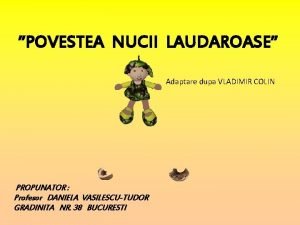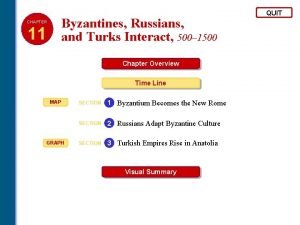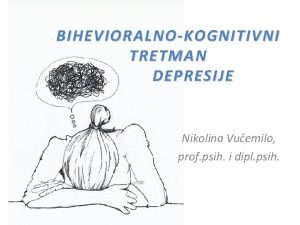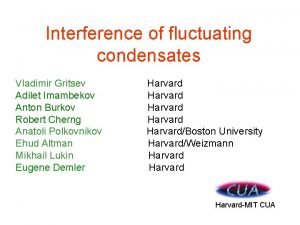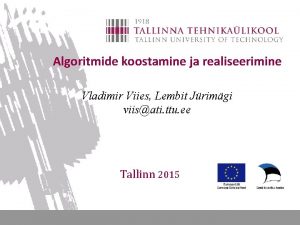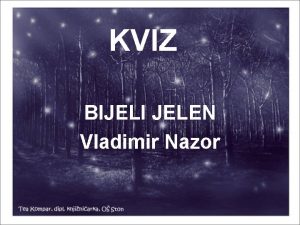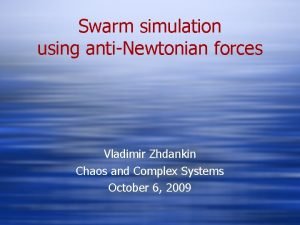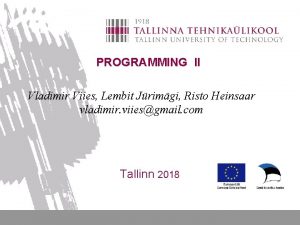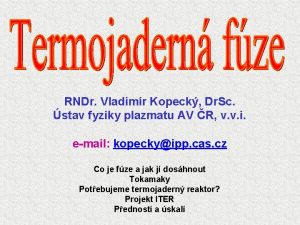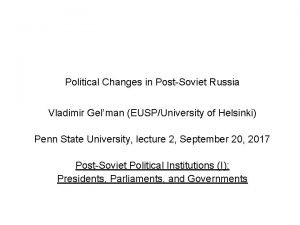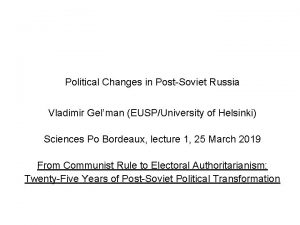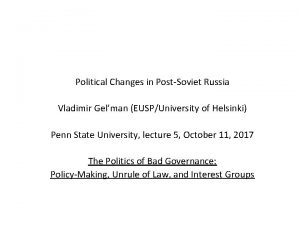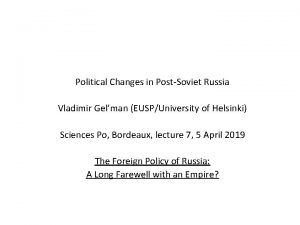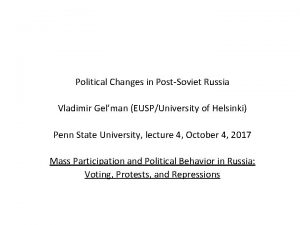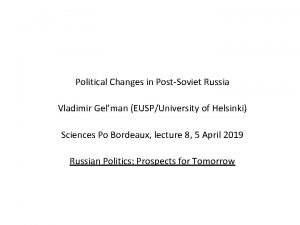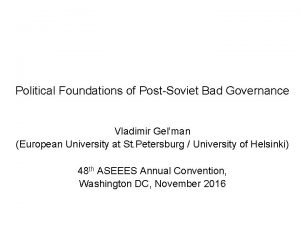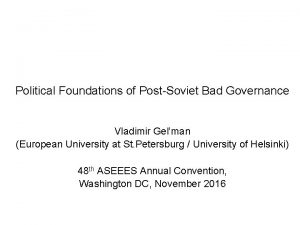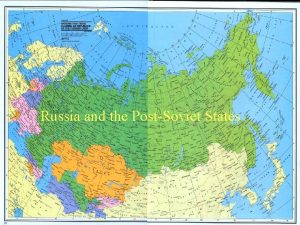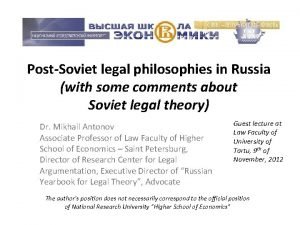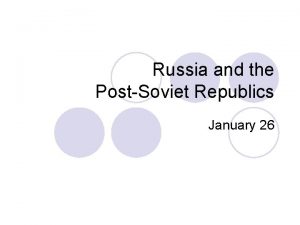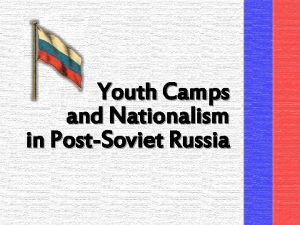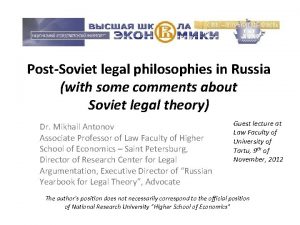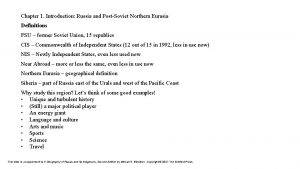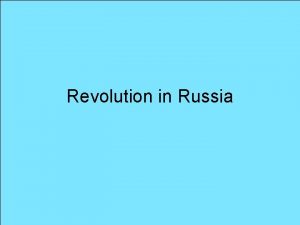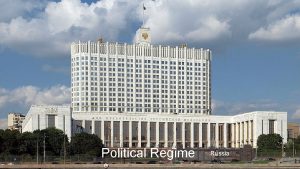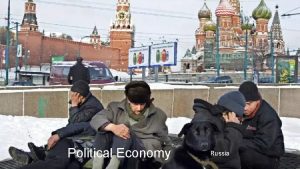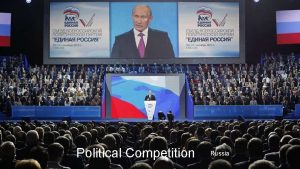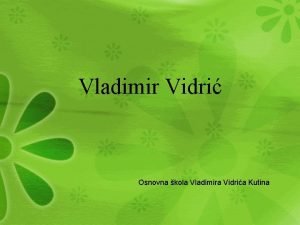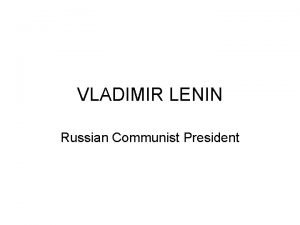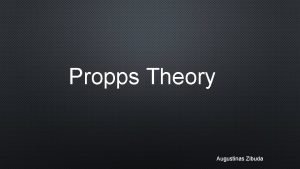Political Changes in PostSoviet Russia Vladimir Gelman EUSPUniversity




























- Slides: 28

Political Changes in Post-Soviet Russia Vladimir Gel’man (EUSP/University of Helsinki) Penn State University, lecture 3, September 27, 2017 Post-Soviet Political Institutions (II): State-building, Decentralization and Recentralization

Post-Soviet Political Institutions • Russia is a multi-layered federal state: • federal government in Moscow, • 83 (or 85? ) regional governments, • about 24000 municipal governments across urban and rural areas; • How Russian federal state is governed? • Why it tend to operate as a hierarchy (“power vertical”)? • To what extent the “power vertical” is sustainable?

Post-Soviet Political Institutions • Political role of any institutions depends upon interaction of three factors: • (1) constitution; • (2) genesis and trajectory of historical evolution; • (3) support among elites and mass public; • And what about federalism? • Federalism – a form of political organization, where some decisions are made exclusively by the federal government, and some decisions are made exclusively by governments of sub-national units (Riker, 1964)

Post-Soviet Political Institutions • If federal government cannot make exclusive decisions, then it is confederation (for instance, European Union); • If governments of sub-national units cannot make exclusive decisions, then it is unitary state (for instance, Ukraine); • The number of federal states in the world is low (22 countries), but many large countries are federations (US, Canada, Mexico, Germany, India, Brazil, Argentine, Nigeria, Australia, etc. ); • … but governing federal states is a complicated matter

Post-Soviet Political Institutions • How Russia fits classifications of federations? • Symmetric vs. asymmetric (e. g. , US vs. India) – Russia is formally symmetric, but… • Territorial vs. ethnic/religious/linguistic (e. g. , US vs. India) – Russia is a mixed model (republics. vs. non-republics); • Number of federal units (from 3 in Belgium to 50 in the US) – Russia is a champion: 80+; • Right for secession – free secession (Soviet Union) vs. prohibition (US) – in Russia it is possible upon nation-wide referendum; • Joint competence – coordinated model (US) vs. cooperative model (Germany) – Russia fits cooperative model;

Post-Soviet Political Institutions • BUT: one should nit mix up two things: federalism and decentralization; • Decentralization – to which degree decisions (whether exclusive or not) are made on subnational or national level; • decentralization – political, administrative, and fiscal (measured through share of federal/subnational taxes) dimensions; • some federal states may be fiscally centralized (Mexico) or decentralized (Canada), but some unitary states may be fiscally centralized (Ukraine) or decentralized, too (Norway); • Russia – went from high fiscal centralization through major fiscal decentralization to mid-range fiscal centralization (now comparable with the US)

Post-Soviet Political Institutions • But to what extent formal framework of federalism in Russia is real or it is just a façade for unitary state? • Most of politically and economically meaningful decisions are made in Moscow rather than in the regions (with some exceptions); • Informal control of Moscow over: • elections in the regions (both national and sub-national), • public behavior (protests, strikes, ethnic tensions etc. ) and public opinion, • economic indicators (unemployment) and major investments; • etc. , etc.

Post-Soviet Political Institutions • Genesis and evolutionary trajectory: • Pre-1917 Russia – multi-ethnic imperial monarchy, centralized hierarchy of government with certain autonomy in some ethnic areas (Finland, Central Asia, Poland); • limited local self-government since 1864 (zemstvo); • … and in 1918 after the Bolshevik revolution Russia proclaimed as a federation; • 1922 - Union Treaty (Soviet Union established as a federation)

Post-Soviet Political Institutions • Soviet federalism: • Ethnic-based; • Multi-layered (four different status groups: union and autonomous republics, autonomous oblast, autonomous districts); • Free secession and free entrance declared; • Changing status of republics over time (repressions, redrawing of boundaries, etc. ); • High level of political, administrative, and fiscal centralization; • Until the late 1980 s federalism remains merely on the paper, but…

Post-Soviet Political Institutions • Ethno-nationalist mobilization contributed to separatism (Baltics, Moldova, Georgia, Armenia, Ukraine) – 1990 -91 referenda on state independence; • The rise of ethnic conflicts (self-proclaimed republics of Abkhazia, South Ossetia, Transdnistria); • … and what about Russia? • The drive to ethno-nationalist mobilization and proclaiming of “sovereignty” in ethnic republics in 1990 -91; • Russian government – weak and incapable to stop these claims; • Appeasement as a successful ad hoc strategy?

Post-Soviet Political Institutions

Post-Soviet Political Institutions • Yeltsin’s speech in August 1990 in Tatarstan: “you can take as much sovereignty as you can swallow”; • Negotiations with ethnic republics regarding their special status in Russia (not implemented in the 1993 constitution); • Non-ethnic units of Russia joined the bargaining process in 1992: a major turn from “Swiss cheese” model to a full-fledged federation; • Appeasement via fiscal transfers – buying loyalty of republican and regional elites (Treisman, 1999); • Political model after 1991: appointment of regional and local chief executives in non-republic regions (aka “power vertical”)

Post-Soviet Political Institutions • Since 1994 – bilateral treaties as a tool of negotiations; • Decline of federal control over fiscal flows (in 1998, federal taxes were of 42% of national budget) and over coercive apparatus (de facto regional control); • Since 1996 – direct popular elections of regional governors, the rise of regional political regimes (instances of sub-national authoritarianism in many cases); • 1998 economic crisis – the huge blow on regional economies, demand for recentralization; • 1999 State Duma election – the struggle between the Kremlin and loose coalition of regional leaders (the Kremlin won); • May 2000 – president Putin announces “federal reform” as a top priority

Post-Soviet Political Institutions • Federal reform, part 1 (2004 -2004): • Federal districts were established, central control over law enforcement and taxation agencies restored; • Regional chief executives and chairs of regional legislatures were removed from the Federation Council; • En masse revision of regional legislation in order to keep it in line with federal regulations; • Tax revolution: revision of taxation rules and restoring of centralized control over major sources of taxation (VAT, unified social tax, subsoil use tax), federal share of taxes increased to 2/3 of all taxes in Russia; • Political tools: encroachment of the Kremlin to regional elections in order to remove “undesired” regional leaders and politicians

Post-Soviet Political Institutions • Federal reform, part 2 (2004 -2012); • Abolishment of popular elections of regional chief executives, turn towards de-facto presidential appointments and dismissals (until 2012); • Elimination of popular elections of city mayors in most (but not in all) of Russia’s big cities, turn toward council-based or city-manager models; • Reforming of regional electoral systems in legislative elections: no less than 50% of seats to lists of nation-wide political parties – United Russia seized control over all of the regional legislatures by 2007; • Major criteria of survival of regional chief executives: political loyalty vs. socio-economic efficiency (Reuter and Robertson, 2012); • Extension of “power vertical” from governors and city mayor to school principals and enterprise directors (Frye et al. , 2014)

Post-Soviet Political Institutions • Case study 1: Tatarstan

Post-Soviet Political Institutions • Leading actor in ”sovereignty” movement in the 1990 s, first bilateral treaty signed in 1994 (political compromise), then extended twice till 2017; • Gains control over taxes (paid only 20% of taxes), assets (including oil company, Tatneft), language issues (de-facto ban on positions in the republican elites for non-Tatars), etc. ; In the 2000 s – decline of special status but still economic priority via federal funding and investment programs and relatively efficient governance •

Post-Soviet Political Institutions • Case study 2 – Chechnya

Post-Soviet Political Institutions • A long history of traditionalism and non-compliance: • Chechen wars in the nineteen century (1819 -59), de-facto special status in imperial Russia; • Rebellions in the 1920 -30 s under Soviet Russia, collaboration with Nazi during World War II, exile into Central Asia (1944), restoration of status of autonomy in 1957; • September 1991 – overthrow of Communist leaders, power seized by nationalist Congress of Chechen people, general Dudaev proclaimed as a president, declaration on independence; • November 1991 – Russian leadership claimed the state of emergency, no way for military solution, de-facto independence (“forgotten area”) till 1994;

Post-Soviet Political Institutions • 1994 - Russian military ground operation (First Chechen war); •

Post-Soviet Political Institutions • Response – terrorist attacks of Chechen guerilla in neighboring regions and counter-attacks to Russian troops; • Temporary solution of 1996 – Khasav-yurt agreement, postponement of solution of status of Chechnya; • De-facto control of field commanders over Chechnya, no re-integration to Russia at all; • 1999 – encroachment of Chechen gangs into Dagestan, bomb explosions in Moscow and in other cities, and the start of the Second Chechen war (1999 -2002)

Post-Soviet Political Institutions • Regaining control over Chechnya – a sense of revenge among Russians; • Better prepared and more efficient military operation, but terrorist responses were harsh (2002 – Moscow, 2004 – Beslan); • Divide-and-rule tactics: Moscow loyalists in Chechnya (Kadyrov)

Post-Soviet Political Institutions • Huge federal funding of Chechnya; • Full control of Kadyrov over the region and much beyond (almost no federal influence); • Dreams of Chechen leaders in the early 1990 s became true under Kadyrov?

Post-Soviet Political Institutions • How the “power vertical” is working? • Not only the chain of commands but also a mechanism of sharing of rents; • Rewards and punishments on the top-down manner (reshufflings of regional and local governments, waves of arrests, etc. ); • Slight adjustments in 2012 – regional chief executive elections restored with “municipal filter” (almost no competition, exceptions which prove the rule); • The new challenges lies ahead?

Post-Soviet Political Institutions • Extension of the ”power vertical” beyond Russia? • Case study 3 – Crimea

Post-Soviet Political Institutions • Crimea – base of Black Sea fleet (Sevastopol), transferred from Russia to Ukraine in 1954 (2 million residents, 12% of Crimean Tatars); • 1991 -2014 – part of independent Ukraine (Crimean autonomy), some pro-Russian support among local residents, special status of naval base; • February 2014 – overthrow of Yanukovych in Ukraine; • March 2014 – Russian annexation of Crimea through popular referendum (83% turnout, 96% for joining Russia) – in most instances the vote reflects sincere will of Crimean residents…

Post-Soviet Political Institutions • What next?

Post-Soviet Political Institutions • Q: what are the strong and weak sides of the model of sub-national governance in Russia, known as the “power vertical”?
 Which letter represents the pyrenees mountains on the map?
Which letter represents the pyrenees mountains on the map? Gelman och gallistels fem principer
Gelman och gallistels fem principer Gelman library
Gelman library Fedics maître d service
Fedics maître d service Cardinal ordinal
Cardinal ordinal Gelman et gallistel
Gelman et gallistel Russian
Russian Example of chemical and physical change
Example of chemical and physical change Elizabeth mulroney
Elizabeth mulroney Inventatori americani
Inventatori americani Halugica vladimir nazor
Halugica vladimir nazor Vladimir batagelj
Vladimir batagelj Vladimír všeslav kráľ
Vladimír všeslav kráľ Vladimir davydenko
Vladimir davydenko Ovo cosmico vladimir kush
Ovo cosmico vladimir kush Yuri and carsten
Yuri and carsten Vladimir mikhailovich komarov
Vladimir mikhailovich komarov Povestea nucii laudaroase
Povestea nucii laudaroase Fingersoft
Fingersoft Personaggi della fiaba
Personaggi della fiaba How did vladimir's conversion to christianity affect kiev
How did vladimir's conversion to christianity affect kiev Vladimir cvijan
Vladimir cvijan Adilet imambekov
Adilet imambekov Vladimir viies
Vladimir viies Bijeli jelen vladimir nazor
Bijeli jelen vladimir nazor Vladimir zhdankin
Vladimir zhdankin Vladimir viies
Vladimir viies Vladimir kopecky
Vladimir kopecky Vladimir viies tud
Vladimir viies tud
